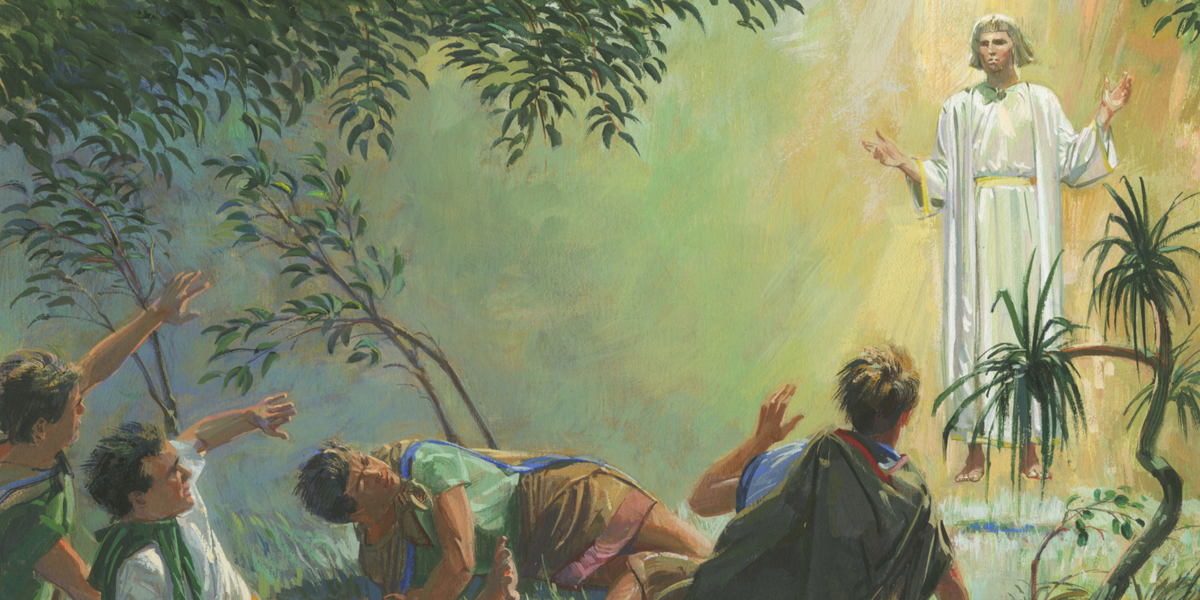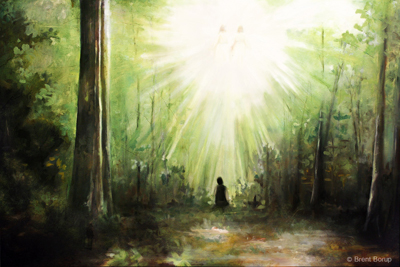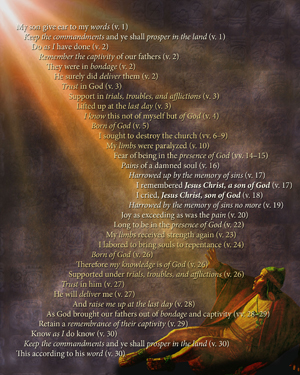
The Know
Most Latter-day Saints are familiar with Joseph Smith’s First Vision through the canonical account found in the Pearl of Great Price (Joseph Smith—History 1:15–20), but this was not the only time Joseph told people about his First Vision. Joseph told the story on many occasions. Today, four different firsthand accounts and a handful of secondhand account survive.1 These various accounts make Joseph Smith’s vision “the best-documented theophany—vision of God—in history,”2 and when studied together can enhance a person’s understanding of that foundational event.
Because events like this are likely defining moments in the lives of the prophets who experience them, it is common for them to give multiple accounts of their visionary experiences. For instance, three accounts of Paul’s vision of the risen Christ are found in the New Testament.3 These different accounts were told or written years apart from each other and to completely different audiences, and thus each offers a different perspective.4
Alma the Younger’s experience with the angel is also recorded multiple times (Mosiah 27:8–37, Alma 36:4–26 and 38:6–8). Alma’s multiple tellings of his conversion story offer several points of comparison with Joseph Smith’s multiple tellings of his First Vision.5
John W. Welch has concluded that the accounts of Alma’s vision differ from each other, in light of their individual settings and audiences, but distinctive details in these three accounts show that they all came from the same person. Evidence for this is found in the repetition of distinctive phrases between the accounts. For example, Mosiah 27:11 states that the angel spoke with “a voice of thunder, which caused the earth to shake upon which they stood,” and Alma 36:7 states: “He spake unto us, as it were the voice of thunder and the whole earth did tremble beneath our feet.” Alma 38:7 does the same thing: “I have seen an angel face to face, and he spake with me, and his voice was as thunder, and it shook the whole earth.”6
Several other phrases in Mosiah 27:28–29, like born of God, the gall of bitterness, marvelous light, racked with eternal torment, and pained no more (Mosiah 27:28–29) are used again in Alma 36.7 Repetitions like this are good evidence that one person experienced and wrote all that the three accounts report. Welch reasoned, “Alma had told his story many times and had grown accustomed to using these characteristic words and phrases.”8
The details in the accounts are impressively consistent. In Mosiah 27 and Alma 36, Alma was told to “arise” (Mosiah 27:12–13; Alma 36:7–8) and “remember the captivity of thy fathers” (Mosiah 27:16; Alma 36:2, 28–29), exactly the same words in both accounts.9 There are also differences between the accounts.10 For example, the sons of Mosiah are mentioned more often in Mosiah 27:18 and 32 than in Alma 36, likely because King Mosiah reported the events in Mosiah 27, whereas Alma composed Alma 36 and 38.11
Another example is Mosiah 27:24–31, a statement which seems unrehearsed. As Welch stated, “They are full of emotion and rejoicing; they are direct, first-person declarations.” In contrast, Welch has noted that Alma’s comments in Alma 36 and 38 “show signs of thoughtful reflection, of years of thinking about his momentous conversion.” 12
For instance, in the later accounts Alma has placed his words into the context of his religious tradition.13 Instead of referring only to his father’s deliverance from Helam (as the angel mentioned in Mosiah 27:16), Alma also referred to older parallels: the deliverance of Lehi from Jerusalem and the Israelites from Egypt (see Alma 36:28–29).14
Other differences are present because Alma “has also applied his spiritual experience to his readers’ daily religious practice, drawing lessons about trusting in the Lord throughout one’s trials, troubles, and afflictions (see Alma 36:3, 27; 38:5), and about living a moral, righteous life (see Alma 38:9–15).”15
Alma even changed the structure from one telling to the next. Mosiah 27:29–30 contains an ancient Israelite poetic style called antithetical parallelism (“I was X, but now I am Y,”) which he repeated four times. In Alma 36, he rearranged these into one “masterfully crafted chiastic composition.”16 The focus of the chiasm is the turning point of Alma’s life, the point when he called upon Christ for forgiveness. He placed the negative attributes from Mosiah 27:29–30 into the first half of the chiasm and their positive opposites into the second half.17
The Why
Prophets, including Alma and Joseph Smith, spoke and wrote about their experiences on multiple occasions in different ways. In the cases of both Alma and Joseph Smith, this was because they were writing about the experience to different audiences at different points in their lives. As Welch noted, referring to Alma,
The three accounts … consistently reflect different vantage points in Alma’s life. In Mosiah 27, Alma is a young man, spontaneously overwhelmed by the power of the angel and terrified by the prospect of the day of judgment (see Mosiah 27:31). Later in Alma’s life, it is clear that the older man has faithfully and successfully served his Lord and his people all the rest of his days (see Alma 36:24–26) so that he now emphasizes his longing to be present with God (see Alma 36:22).18
This is not to say that either Joseph or Alma made things up as they went along. Rather, their variation in details seems to have been prompted by their varying audiences and inspired by what they had been going through in their individual lives.19 In the 1832 account, for example, Joseph focused on the esence of the Savior and only alluded to the presence of the Father because he was focusing more on the atoning power of Christ.20 Yet in both the case of Alma and Joseph, the retellings have all the hallmarks of a genuine memory being told and retold over a lifetime. When seen together, the different accounts create a coherent picture that it what one would expect from a real story being told at different times to different audiences.
Both Joseph Smith and Alma seem to have gone back to their memories of these visions repeatedly throughout their lives, turning to them as a source of strength and using them to teach others.21 It may well have been hard, if not impossible, for Joseph and Alma to even explain such overwhelmingly glorious events to the people around them, yet they did their best, knowing how much their experiences could help others. As Welch noted, referring to Alma, “these three accounts still profoundly bear the unmistakable imprints of a single distinctive person, who throughout his adult lifetime had lived with, thought about, matured through, and insightfully taught by means of his powerful and beautiful conversion story.”22 And of Joseph Smith, one can similarly conclude: “There is, in fact, striking consistency throughout the narratives [of the First Vision]; they combine impressively to give a consistent and coherent picture . . ., showing a high degree of interdependent, cumulative corroboration among these accounts.”23
Alma and Joseph Smith drew strength from their spiritual experiences and used them to teach others. In the same way, modern readers of the Book of Mormon can return repeatedly to the spiritual experiences in their lives as a source of strength. They can also, like Alma and Joseph, repeatedly ponder the significance of these events and apply their spiritual experiences to their daily religious practice, drawing lesson after lesson from the same experience at different points in their lives, depending on their circumstances.
Further Reading
John A. Tvedtnes, “The Voice of an Angel,” in Book of Mormon Authorship Revisited, ed. Noel B. Reynolds (Provo, UT: FARMS, 1997), 311–321.
S. Kent Brown, “Alma’s Conversion: Reminiscences in His Sermons,” in The Book of Mormon: Alma, The Testimony of the Word, ed. Monte S. Nyman and Charles D. Tate, Jr. (Provo, UT: Religious Studies Center, Brigham Young University, 1993), 141–156.
John W. Welch, “Three Accounts of Alma's Conversion,” in Reexploring the Book of Mormon: A Decade of New Research, ed. John W. Welch (Salt Lake City and Provo, UT: Deseret Book and FARMS, 1992), 150–153.
- 1. The Church and Brigham Young University, in numerous books and journals, have published for many years extensive resources on the various accounts of the First Vision. Beginning in 1969, Dean C. Jessee published “The Early Accounts of Joseph Smith’s First Vision,” in BYU Studies, 9 no. 3 (1969): 275-94, followed soon by James B. Allen, “Eight Contemporary Accounts of Joseph Smith’s First Vision – What Do We Learn from Them,” Improvement Era 73 (April 1970): 4–13; and Milton V. Backman Jr., Joseph Smith’s First Vision: Confirming Evidences and Contemporary Accounts (Salt Lake City: Bookcraft, 1971; 2nd edition, 1980). See also Milton V. Backman Jr., “Joseph Smith’s Recitals of the First Vision,” Ensign, January 1985, 8–17; and articles in the Encyclopedia of Mormonism (1992).
More recently, see Richard L. Anderson, “Joseph Smith’s Testimony of the First Vision,” Ensign, April 1996, 10–21; Dean C. Jessee, Mark Ashurst-McGee, and Richard L. Jensen, eds., Journals, Volume 1:1832–1839, The Joseph Smith Papers (Salt Lake City, UT: Church Historian’s Press, 2008); Karen Lynn Davidson, David J. Whittaker, Mark Ashurst-McGee, and Richard L. Jensen, eds., Histories, 1832–1844, The Joseph Smith Papers (Salt Lake City, UT: Church Historian’s Press, 2012); Steven C. Harper, “The First Vision: A Narrative from Joseph Smith’s Accounts,” Church History, April 27, 2016; “First Vision Accounts” Gospel Topics, online on lds.org; and Elder Richard J. Maynes, “The Truth Restored,” CES Worldwide Devotional for Young Adults, May 1, 2016, online on lds.org.
For important current studies about the First Vision, see Samuel Alonzo Dodge and Steven C. Harper, Exploring the First Vision (Provo, UT: Religious Studies Center, Brigham Young University, 2012); Richard L. Bushman, Joseph Smith: Rough Stone Rolling (New York, NY: Vintage Books, 2005), 30–56; Matthew B. Brown, A Pillar of Light: The History and Message of the First Vision (American Fork, UT: Covenant Communications, 2009); Steven C. Harper, “Suspicion or Trust: Reading the Accounts of Joseph Smith’s First Vision,” in No Weapon Shall Prosper: New Light on Sensitive Issues, ed. Robert L. Millet (Salt Lake City and Provo, UT: Deseret Book and Religious Studies Center, Brigham Young University, 2011), 63–76; Steven C. Harper, Joseph Smith’s First Vision: A Guide to the Historical Accounts (Salt Lake City, UT: Deseret Book, 2012); Matthew B. Christensen, The First Vision: A Harmonization of 10 Accounts from the Sacred Grove (Springville, UT: Cedar Fort, 2014); Steven C. Harper, “Remembering the First Vision,” in A Reason for Faith: Navigating LDS Doctrine & Church History, ed. Laura Harris Hales (Salt Lake City and Provo, UT: Deseret Book and Religious Studies Center, Brigham Young University, 2016), 7–20. - 2. Harper, Joseph Smith’s First Vision, 1.
- 3. See Acts 9:3–30; 22:6–21; 26:12–21; see in addition 2 Corinthians 11:32–33 and Galatians 1:15–24.
- 4. John A. Tvedtnes, “The Voice of an Angel,” in Book of Mormon Authorship Revisited, ed. Noel B. Reynolds (Provo, UT: FARMS, 1997), 312. For comparison of Paul’s various accounts, see John A. Tvedtnes, “Variants in the Stories of the First Vision of Joseph Smith and Apostle Paul,” Interpreter: A Journal of Momron Scripture 2 (2012): 73–86.
- 5. On comparing Alma’s accounts, see John W. Welch, “Three Accounts of Alma's Conversion,” in Reexploring the Book of Mormon: A Decade of New Research, ed. John W. Welch (Salt Lake City and Provo, UT: Deseret Book and FARMS, 1992), 150. On comparing Joseph Smith’s accounts, see James B. Allen and John W. Welch, “The Appearance of the Father and the Son to Joseph Smith in 1820,” in Opening the Heavens: Accounts of Divine Manifestations 1820-1844 (Salt Lake City, UT: Deseret Book and BYU Press, 2005; 2nd edition, 2017), 35-75.
- 6. Welch, “Three Accounts of Alma’s Conversion,” 151.
- 7. “God did rack my soul” (Alma 36:14) “with eternal torment” (Alma 36:12). “I cried . . . have mercy on me, who am in the gall of bitterness” (v. 18). “I could remember my pains no more” (v. 19). “What marvelous light” (Alma 36:20). “I had been born of God” (v. 23).
- 8. Welch, “Three Accounts of Alma’s Conversion,” 151.
- 9. Welch, “Three Accounts of Alma’s Conversion,” 151.
- 10. See John W. Welch and J. Gregory Welch, Charting the Book of Mormon: Visual Aids for Personal Study and Teaching (Provo, UT: FARMS, 1999), chart 106.
- 11. Welch, “Three Accounts of Alma’s Conversion,” 151.
- 12. Welch, “Three Accounts of Alma’s Conversion,” 151.
- 13. Welch, “Three Accounts of Alma’s Conversion,” 152.
- 14. Welch, “Three Accounts of Alma’s Conversion,” 152.
- 15. Welch, “Three Accounts of Alma’s Conversion,” 152.
- 16. Welch, “Three Accounts of Alma’s Conversion,” 152. See also Book of Mormon Central, “Why Was Alma Converted? (Alma 36:21),” KnoWhy 144 (July 15, 2016); John W. Welch, “A Masterpiece: Alma 36,” in Rediscovering the Book of Mormon: Insights You May Have Missed Before, ed. John L. Sorenson and Melvin J. Thorne (Salt Lake City and Provo, UT: Deseret Book and FARMS, 1991), 114–131.
- 17. Welch, “Three Accounts of Alma’s Conversion,” 152. Welch also noted that “Alma 38 is equally interesting. It presents essentially the first half of the chiasm found in Alma 36, up to the climactic turning point, before shifting into hortatory speech admonishing his second son. Having given the doubled version to his eldest son, Helaman, in Alma 36, Alma evidently felt no need to give the fully repeated structure to Shiblon in Alma 38.
- 18. Welch, “Three Accounts of Alma’s Conversion,” 153.
- 19. See Allen and Welch, “Appearance of the Father and Son,” 37.
- 20. Allen and Welch, “Appearance of the Father and Son,” 63.
- 21. Compare Alma 5:7–14 to Alma 36. See S. Kent Brown, “Alma’s Conversion: Reminiscences in His Sermons,” in The Book of Mormon: Alma, The Testimony of the Word, ed. Monte S. Nyman and Charles D. Tate, Jr. (Provo, UT: Religious Studies Center, Brigham Young University, 1993), 144.
- 22. Welch, “Three Accounts of Alma’s Conversion,” 153.
- 23. Allen and Welch, “Appearance of the Father and the Son,” 70.
Continue reading at the original source →







